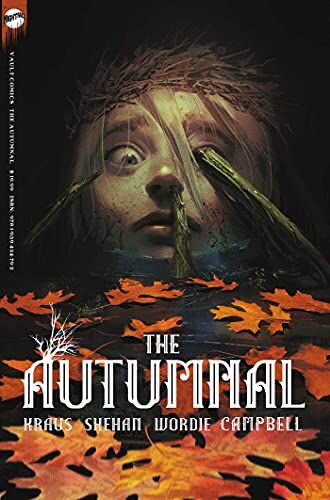Something strange is happening at Comfort Notch. Joining the ranks of other malevolent township imaginings such as Derry, Arkham, and Riverdale, this New England-inspired setting may fool you at first only to violently push you in a pile of leaves. Is it eco-horror or something more cosmic? Judging by the first three issues of The Autumnal (2020) we’re still early from raking in any answers, but that doesn’t stop the shadowy warnings from creeping into your subconscious.
Kat Somerville -donning a black leather jacket and a pair of sunglasses- is on her way to the principal’s office again to discuss another incident involving her daughter. Underneath the shades hides a black eye that gives a hint to her vices and proclivity toward violence. Her daughter, Sybil, shares that tendency (medically diagnosed as “Intermittent Explosive Disorder”). Kat – prior to the meeting- learns that her estranged mother has passed away, and that a mysterious party has bequeathed her the deceased’s home. So when things turn dicey at the principal’s office, they flee to Comfort Notch, New Hampshire leaving behind her daughters school and Rich – Sybil’s absent father. Will this Fall-painted town offer the new beginning that she’s hoping for?
An overarching mother-daughter story is at the heart of The Autumnal, contrasting Kat’s protective relationship with Sybil against the – seemingly- non-existent one with her own mother. Surprisingly, Kat isn’t the only one with disdain for her matriarch Trudy, as the entire town appears to share the sentiment, resulting in an empty church for her funeral and the seemingly-chipper townsfolk to openly speak ill of her. Left with a house full of metaphorical ghosts and nothing but time to investigate, Kat will soon learn the reasons behind her mother’s questionable actions, and how she might be connected to the weirdness in this very uncomfortable town.
Sometimes the best use of horror comes from evoking fear in the mundane. Look at how Hitchcock made you look twice before hopping in the shower, or how The Conjuring (2013) triggered audiences with a simple clap. Thanks to the artist, Chris Shehan, and colorist, Jim Campbell, The Autumnal somehow manages to transform fall foliage into an ominous void. Orange leaves clog the gutters between panels making for a menacing motif once we arrive at the enigmatic town. The townsfolk are constantly observed raking leaves and warning the characters to stay out of the piles leaving you to wonder what’s lurking beneath. Even worse, leaves are shown in more graphic imagery as part of strange deaths and odd funerary rituals. Nature aside though, the town itself is absolutely suspicious as we encounter haunting nursery rhymes and creepy infantile scribblings all hinting to something mysterious and sinister living in the trees.
Puzzle Box Horror may earn a commission when you buy through links on our site.
Part of the joy of reading The Autumnal comes from the storytelling of author Daniel Kraus, who received recent praise for his co-authorship on George A. Romero’s posthumous novel, The Living Dead (2020). Kraus has also worked with Guillermo Del Toro on the novel adaption of the Oscar-winning film, The Shape of Water (2017). Clearly influenced by the previously mentioned counterparts, Kraus is soaring through the literary world at lightspeed and with a range that leaves you wondering what he’ll possibly unleash next. However, based on Kraus repertoire, we’ve just touched the surface of The Autumnal and we are most likely in for a treat.
These first three issues introduce us to an intriguing and authentic mother-daughter duo that I’m eager to watch develop in the coming issues. There’s also much to be learned about the pastoral town and whatever diabolical secret it appears to be hiding. This is definitely a series that you’re not going to want to fall behind on. However, while you wait for the remaining issues maybe it’s best that you avoid frolicking through any of those enticing-looking piles of leaves

Like most Constant Readers, Max’s love of horror began with Stephen King. After devouring stories of rabid dogs, sinister cars, and bloodied prom queens he went on to the next best thing: Slashers. While he enjoys the mindlessness of Jason Takes Manhattan and Malignant, he’s also a major sucker for complex stories like Midsommar, The Only Good Indians, and Get Out where the genre is used to tackle very real horrors that don’t wear a mask. Horror films may take up most of the space on his shelves, but he also has a deep love for comics and literature that can make you look over your shoulder without the suspenseful score.
When he’s not consuming every medium of entertainment, Max works in Civil Engineering while finding time to be a struggling writer. He writes for his own personal enjoyment and occasionally for the pleasure of others with hopes of eventually publishing a work of his own. He believes that horror is the one genre that isn’t afraid to explore the world with full and total honesty.


